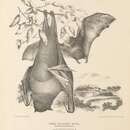Biology
provided by Arkive
Grey-headed flying foxes roost in large colonies, or 'camps', of up to tens of thousands of individuals among exposed branches during the day (7) (8). At dusk these bats emerge from the colony in search of food (9) (10), travelling up to 50 kilometres to their feeding areas (11) (12) (13). Their diet consists of fruit from a range of native and introduced species, as well as pollen and nectar, particularly of Eucalypt trees (11) (14) (15) (16) (17).
Breeding is seasonal, and from January onwards males defend mating territories, which they demarcate by scent-marking, loud calls and aggression (18). Mating generally occurs between March and May (18) (19), with a single young born six months later between September and November (15). Females then carry their pup during foraging flights for the first three weeks, after which they are left behind in the camp (4) (15). Young are capable of flight and follow their mother to forage after three months, but are not weaned until five to six months (15) (19) (18).
Conservation
provided by Arkive
In response to these growing threats, roost sites have been legally protected since 1986 in New South Wales and 1994 in Queensland (22). The grey-headed flying fox was also listed as vulnerable under the Environment Protection and Biodiversity Conservation Act in 1999, and the New South Wales Threatened Species Conservation Act Schedule 2 in 1995, which required that a Recovery Plan be prepared by 2006 (27) (29) (30). Conservation reserves are limited, and future efforts to protect more key foraging areas would be extremely beneficial, by helping to ensure that food supplies are available throughout the year (2). Research into alternative, non-lethal crop protection mechanisms, and encouragement of horticulturists to use them, is also crucial in the fight to protect this species (2). As important pollinators and seed dispersal agents, these bats are integral in maintaining healthy forest ecosystems (16). Thus, unless swift action is taken to halt further population reductions, the decline of the grey-headed flying fox is likely to have a serious negative, long-term impact on the regeneration of Australia's forests, and the host of unique fauna they harbour.
Description
provided by Arkive
The grey-headed flying fox is one of the largest bats in Australia, with the maximum recorded wingspan exceeding an impressive 1.5 metres (4). This bat has a dark grey body, a paler grey head, and a conspicuous collar of rich russet-coloured fur encircling the neck (4). As with all members of the Pteropodidae family, this bat lacks a tail and has claws on the first and second digits. Uniquely, however, the body fur of this species extends all the way down to the ankle, distinguishing it from other flying foxes (Pteropus species), which only bear fur down to their knees (4).
Habitat
provided by Arkive
Found in a variety of habitats, including rainforests, woodlands, mangroves, swamps, but also in suburban and cultivated areas (4) (5). Typically found no more than 100 kilometres inland, and amongst trees at around 200 metres above sea level, although individuals have been recorded at elevations as great as 700 metres (4).
Range
provided by Arkive
Endemic to the east coast of Australia, from Bundaberg in Queensland to Melbourne in Victoria (4) (5) (6).
Status
provided by Arkive
Classified as Vulnerable (VU) on the IUCN Red List (1), and listed on Appendix II of CITES (3). Listed as Vulnerable on the New South Wales Threatened Species Conservation Act 1995 and the Commonwealth Environment Protection and Biodiversity Conservation Act 1999 in Australia (2).
Threats
provided by Arkive
Although once thought to number in their millions, in 2002 there were estimated to be around 400,000 grey-headed flying foxes remaining (20). The most significant threat facing the bat is the destruction of foraging and roosting habitat due to expanding urbanisation and agriculture (7) (15). Climate change may also pose a threat to the grey-headed flying-fox as climate models are predicting significant increases in the occurrence of temperature extremes and recent research has shown that since 1994, more than 24,500 grey-headed flying foxes have died in their roosts when temperatures exceeded 42 degrees Celsius (21). Another serious threat is direct killing of animals in orchards and destruction of roosts. Many farmers perceive the bats to be pests due to the destruction they cause to crops and often kill them (22). Further more, negative public perception and consequent persecution of the species has intensified in the last decade with the discovery that it carries three new diseases that are potentially fatal to humans, Hendravirus, Menanglevirus and Australian Bat Lyssavirus (23) (24) (25). The exact numbers of bats killed is unknown, but estimates have been made as high as 100,000 annually, with the death of pregnant or lactating females obviously having an additional knock-on impact on the survival of their young (26). There is also a tendency for these bats to fly into power lines and die from electrocution. Black flying foxes (Pteropus alecto) pose a further threat through competition for food and habitat, and hybridisation between the grey-headed flying fox and the black flying fox has been observed (7) (27) (28).

